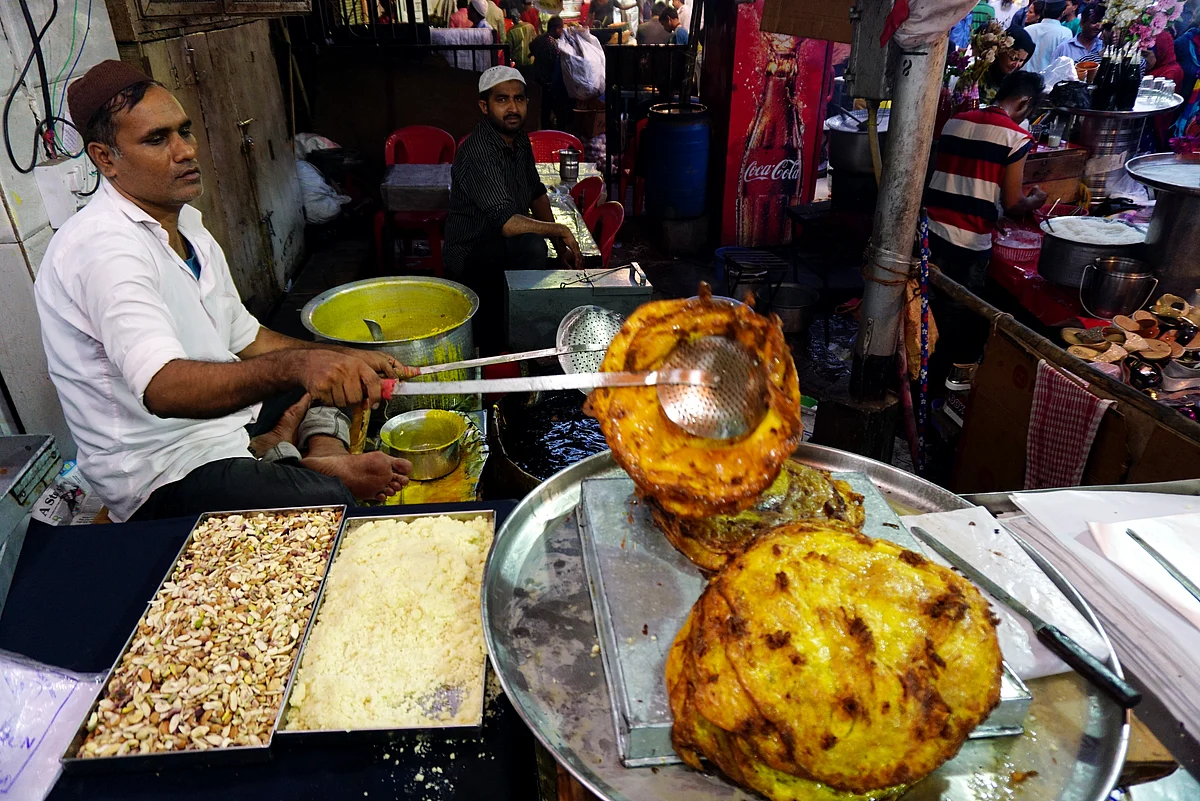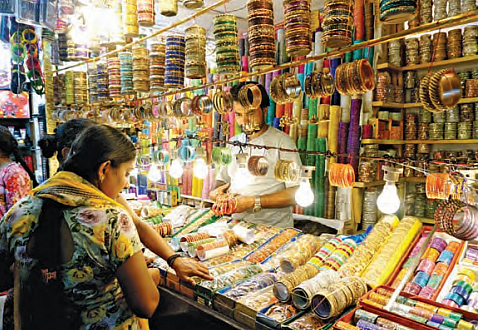Ramzan and the Taste of Togetherness
When Hindus flock to Mohammed Ali Road during the holy month of Ramzan, “ek apnapan sa lagta hai,” say restaurateurs

Come Ramzan, all roads in Mumbai lead to Minara Masjid. This year was no different. March 23 onward, the bylanes of Mohammed Ali Road have been aglow with lights and abuzz with people, Hindus and Muslims breaking bread together, foodies and faithful alike.
Throngs of selfie-takers and memory-makers, office-goers and bargain-hunters can be spotted cheek by jowl with those who have offered their prayers and broken their fast. It’s a joy to behold, especially in the face of the current dispensation’s anti-Muslim narrative, a reminder that Mumbai still has its heart in the right place. During the holy month, Mohammed Ali Road is certainly the heart of foodie heaven. Friends and families from in and out of town flock there—all drawn by the raunaq and barkat of celebration.
For a whole month the economy of these streets gets a huge boost, the way Crawford Market, for instance, does during Diwali, with shops staying open well past midnight. As you walk, or wait your turn for that mouth-watering malpua, it’s par for the course to hear many tongues around you— Marathi, English, Hindi, Urdu, Gujarati, Tamil, Punjabi, Bengali, Himachali, Oriya, Assamese, even French, German or Spanish.
Most food vendors say, however, that the daily crowds are primarily Maharashtrian. And not only from the state but also from outside, as I learned the evening I made tracks to Mohammed Ali Road. A group of media students (both vegetarian and non-) are nosing around, savouring the scents and flavours. While the vegetarians make a beeline for the malpua and firni, the meat-eaters are spoilt for choice.

“This is our first time here, we were urged by our teacher and our friends to visit Mohammed Ali Road. I am a non-vegetarian, so I am going to go for the chicken tikka kebab,” said Shruti Gupta from Kolkata, a media student currently studying in Mumbai.
Among the first-timers are the Kakade twins from Indore. Tulza Kakade said their stay in Mumbai would have been incomplete without a visit to Mohammed Ali Road. “A lot of reels on Instagram brought me here. I’m excited to eat seekh kebabs. Food is above all socio-political noise, and also, Mumbai wouldn’t be the same if it were not for these festivals that we celebrate together. See how diverse we are and yet, we celebrate together, very closely.”
According to Rudraksh, her twin, “Ramzan is the best time to come here and not just for the food. The place is lit up and the vibes here are warm and festive. None of us had second thoughts about coming here.”
Among globetrotters keen on local cuisine was a British couple, James and Julie. James recounted a near-death experience that he had on a flight a few years ago—a cardiac arrest that he recovered from at a hospital in Andheri. This year, he’s back to visit friends who helped him. “I have visited Dubai, Oman and other Middle-Eastern countries during Ramzan. This time, I’m in Mumbai to celebrate my rebirth. Celebrations in Oman and Dubai are quieter and [more] restrained. Here, like everything else, even Ramzan celebrations are wild and noisy.
“It is exciting to come here in the evenings. The food has distinctly Indian flavours, be it of any community. In Oman, for instance the blend of flavours is different. Here, there are many more vegetarian options. We have come here during Ganesh Chaturthi and even during the floods, and I must say the food is the same— always good. I have seen that they are an extremely friendly and welcoming community and their cuisine is wonderful,” said James, as Julie, his wife, nodded enthusiastically.
In contrast, Steve and Rachel, another British couple on the food trail at Minara Masjid with their Muslim guide, find it too noisy and crowded. This is their first time ever on the Ramzan tour and they are overwhelmed. “It is nice to appreciate a different culture and cuisine,” said Rachel. “Yes, it’s really nice and overwhelming.” Steve seems to have vibed a bit better with the multicultural mix, “There are so many different people, so many cultures and different foods to eat in just one place. Ramzan is an interesting experience. It was nice to see the joyous celebrations after a daylong fast.”
Thanks to social media platforms, Ramzan celebrations have become a priority on people’s bucket lists. There are walking tours and festive food-hopping trips, which have become quite the fad. And one can see why, with some items on the menu only during Ramzan. Every day the live kitchens use fresh ingredients, none of which are stored or frozen. Just to understand the massive scale on which food is cooked here, on an average, 13,000 eggs are used daily for the special malpuas by just one eatery, the Shalimar Restaurant. The malpuas are the super-speciality of the street.
Shopkeepers source spices and ingredients through the year, putting it all together for the monthlong fast and the night before Eid. Other special items include a scrumptious soup, sundal and bater (quail kebab). The haleem and khichda served during this time are also very popular. For vegetarians, there is paneer butter masala to match the butter chicken, peas patties to challenge the seekh kebabs, yummy dals, kathal (jackfruit) biryanis that some aver top even the mutton biryani in terms of deliciousness, and seasonal vegetables in finger-licking masalas that linger on your taste buds for hours afterwards. Among the regulars are Priya and Dhruva Srinivasan. The couple from Dadar has been coming here for two decades now. While Priya eats the non-vegetarian delicacies, Dhruva, a vegetarian, sticks to the sweets. Familiar with the shop vendors and au fait with who sells what, Priya hands the vendor a box to pack haleem to take home. “For the last 20 years, my husband Dhruva and I have been coming every single year. We get the same quality and fresh food. You can never go wrong here. I come to buy khichda or haleem, which you only get here. Nothing has changed in all these years, as far as my experience goes,” she said.

Priya recalls an incident with her brother which, in a nutshell, sums up the quality of the food on Mohammed Ali Road. “Some years ago, my brother had come down from the US and on the last day, I told him he should come here with me. Of course, my mother was not in favour [of this plan], because she feared he would end up with an upset stomach. I said, just come on, yahaan khao toh zara, kuchh nahi hone wala hai. He ate everything he wanted, stuffed himself silly and was fit as a fiddle the next day. He flew back greatly satisfied and happy with the adventure,” she said.
Many believe it’s the social media hype and a craze to be where the action is that explains the lure of the place. Sayeed Hamid, an Urdu journalist who lives in Andheri, has been coming here for the last 40 years. He says this place unites the people of Mumbai. “I can say Mohammed Ali Road has been the centre of food and cultural unison for all communities, including various Muslim communities. The ambience is of an interfaith celebration during the night. After roza and until sehri, this food unites all the people of our city, every night,” Sayeed observed.
Meanwhile, Gillani Nooruddin, owner of Modern Sweets, who has never missed a single Ramzan, looks on happily at customers being served their favourite malpuas. He finds that over the years, the festival has become a lot more inclusive. “It was rare to see non-Muslims visiting the Minara Masjid area a couple of decades ago. Now, they comprise at least 50 per cent of the crowd. People from other towns and cities come here especially to eat Ramzan food. Ek apnapan sa lagta hai. It warms our hearts to see them feel at home,” says a smiling Gillani.
Amin Parekh, the block president of the Congress party points out that even before the social media era, it was when celebrities began visiting during Ramzan that Mohammed Ali Road first began attracting non-Muslim crowds. “Now, social media plays an important role in promoting unity, which is seen even during other festivals in Mumbai. The most crucial role is that of the word-ofmouth publicity, despite the politics seen [being] played out.”
As Mayur, a food lover said, “Of course, Mohammed Ali Road in real life is so happily different from what is otherwise told to us. Food is the winner, be it Ramzan or any other festival. We come here regularly because we get quality food here.”
Office-goers come for a night out and, like pub hopping, they go ‘food hopping’ from street food to restaurant food. The most popular restaurants are Bade Miyaan, Shalimar and Jafferbhai Delhi Durbar. These restaurants have also drawn up a good vegetarian menu, given that many vegans and vegetarians also want to be part of the celebrations. The concept of iftar boxes has caught on. Even during the Covid-19 pandemic, there was a huge demand for iftar gift boxes, sent to family members and non-Muslim friends, to draw them into the festivities.
Waseem Pathan, the general manager of Shalimar, Dongri, explains, “These iftar boxes are special. Every fortnight, the menu changes, whether vegetarian or non-vegetarian. In fact, the demand for these boxes has increased by five per cent every year. During Covid, the takeaways and boxes were in high demand, as business at the restaurant was virtually halved. Since 2022, the footfall has improved and now we are back on track.”
Hassan Jaffer, owner, Jafferbhai’s Delhi Durbar, says this bonhomie needs to stay intact permanently and it needs to go beyond posturing. “We need this genuine interaction in today’s times, not just a hypocritical show of emotions. We all need to share food, share a bond and be true friends, whichever community we may belong to. Some people are influenced by some unsavoury events that have occurred in our city, due to which they may prefer to stay away. But the majority are not like that. Here, at Mohammed Ali Road, everyone has a sense of belonging. At all the restaurants, 60-70 per cent of the patrons are Hindu. So, we neither serve beef, nor do we eat beef. Chicken and lamb is the staple for non-vegetarians. Paneer and potatoes are big on the vegetarian menu,” Hassan said.
He gives credit to Instagram and Facebook users, and also food bloggers, for being honest. “As a result, many non-Muslim food lovers come from Surat, Ahmedabad, Jaipur, Indore, Calcutta and even Lucknow and Delhi. They take the Shatabdi, or the morning flight, spend a few hours here and go back the same night.”
Just then Afzal Vaid calls, wanting to send an iftar box to his Punjabi friend. “There are many non-vegetarian dishes and items in this one box. You can sit with your family and eat together in your own home, enjoying the food. It’s a different feeling. Many of my friends wait for Ramzan time, just like I wait for their sweets during Diwali and Ganpati. This is what friendship is, to exchange and share with each other,” said Vaid.
This is also what India is, was and hopefully will always be despite attempts by some to divide and rule. You only have to go to Mohammed Ali Road during Ramzan to renew your faith in the power of food to bring people together.
Follow us on: Facebook, Twitter, Google News, Instagram
Join our official telegram channel (@nationalherald) and stay updated with the latest headlines
